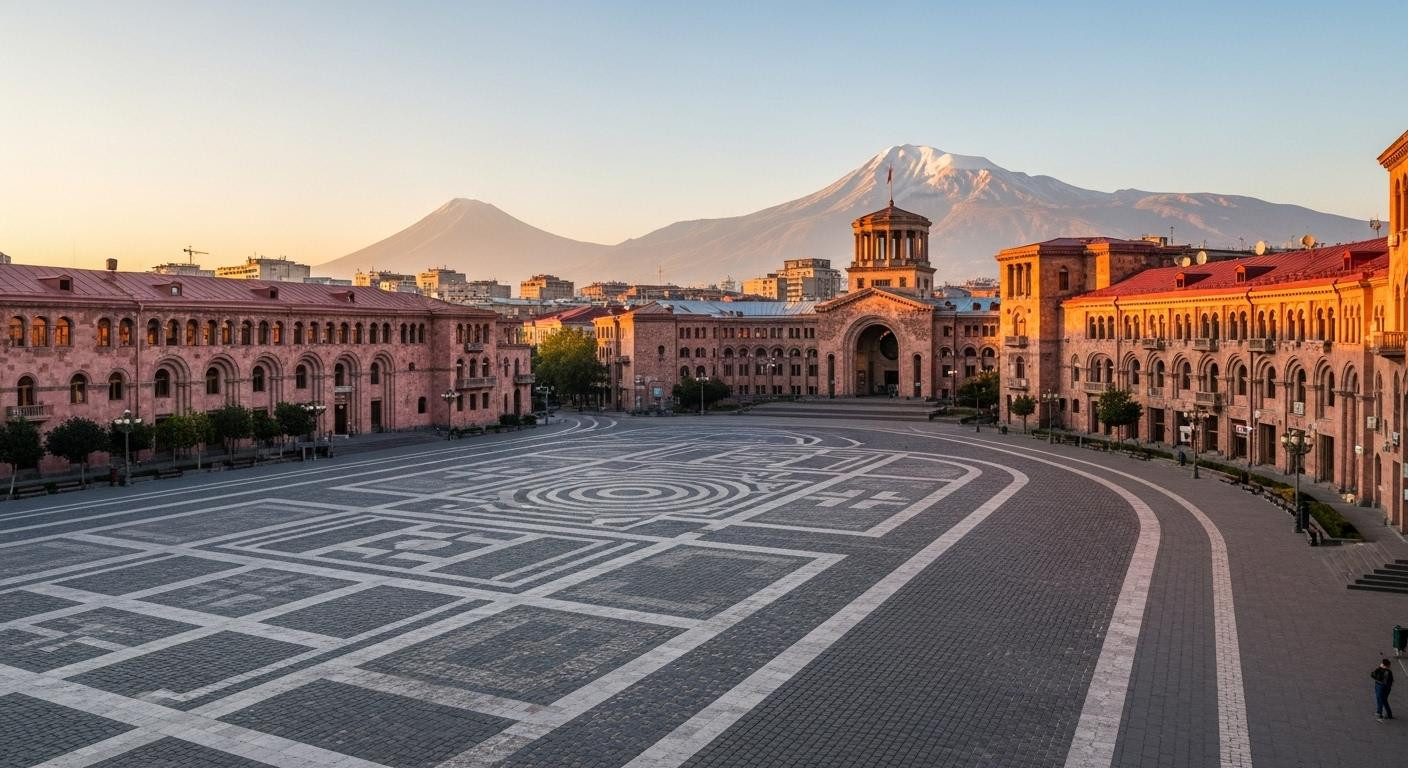Dawn breaks over Republic Square as pink tuff stone glows amber in morning light. A local unlocks the Cascade Complex escalators while Mount Ararat emerges through soft haze. Three days ago, Caucasus capitals meant Tbilisi’s crowded wine bars or Istanbul’s tourist-packed Grand Bazaar. Now, standing where 2,800 years of Armenian history costs 40% less with one-tenth the crowds, something fundamental crystallizes about authentic travel.
Where pink stone meets ancient silence
Yerevan’s distinctive tuff stone architecture creates warmth Istanbul’s Ottoman palaces can’t match. The city sits 3,280 feet above sea level, framing Mount Ararat views through clear mountain air.
The 1.1 million residents navigate streets where 782 BCE foundations still anchor modern cafés. Geographic positioning in the Hrazdan River valley offers accessibility from European hubs in 3-5 hours. This positioning mirrors other Eastern European capitals balancing heritage preservation with growing tourism.
Pink-golden buildings catch sunset light differently than anywhere else. The volcanic tuff stone, quarried from surrounding mountains, gives Republic Square its signature glow at golden hour.
The capital Tbilisi was before discovery
While tourists crowd Tbilisi’s 4 million annual visitors and Istanbul’s overwhelming 15 million, Yerevan quietly receives 1.5 million travelers. This creates the authentic urban experience Tbilisi offered a decade ago.
Architectural heritage without Instagram saturation
The Cascade Complex’s 572 steps climb through terraced gardens without selfie stick crowds. Erebuni Fortress holds UNESCO World Heritage candidate status while maintaining peaceful contemplation spaces.
Soviet Brutalist architecture blends with vernacular Armenian styles. This fusion creates visual depth beyond simple photo opportunities.
Cultural depth versus tourist performance
The Armenian Genocide Memorial Complex offers solemn reflection without commercialized tours. Local historians maintain exhibits where 1.5 million annual visitors can process history authentically.
Like other ancient spiritual sites, Yerevan preserves living history where locals still use ancient gathering spaces daily.
Living like Yerevan’s 1.1 million residents
Budget-conscious travelers discover genuine advantages over regional alternatives. Hotel costs average $60-100 nightly for mid-range accommodation, delivering what costs $120-200 in Tbilisi.
The $15 meal economy
Khorovats (Armenian barbecue) at family taverns costs $6-10 per serving. Traditional dolma and lavash bread meals average $10-15 at authentic restaurants.
The Vernissage Market opens at 8 AM before tourist arrival. Fresh produce, handwoven carpets, and traditional jewelry remain competitively priced for locals.
The metro advantage
Single metro rides cost just $0.20, the cheapest among Caucasus capitals. The Yerevan Card ($25-35 for three days) covers museum entry, metro rides, and airport transfer.
Local marshrutka buses connect neighborhoods at $0.35 per ride. Walking culture dominates central districts where pedestrian zones extend for miles.
When numbers reveal what comparisons hide
Statistics tell only part of Yerevan’s story. The 1.5 million annual visitors mean restaurant reservations aren’t required during peak summer months.
Republic Square fountains at 6:47 AM belong to locals practicing tai chi. Mount Ararat views from the Cascade remain unobstructed by tour groups throughout most days.
This isn’t “undiscovered” but strategically protected. Armenian hospitality thrives because tourism density hasn’t crushed intimacy. The Matenadaran manuscripts, the 2,800-year timeline, pink stone glowing at dusk transform from attractions into lived experiences.
Early morning markets preserve authentic local commerce before tourist hours begin.
Your questions about Yerevan answered
How does Yerevan’s cost compare to Tbilisi and Istanbul in 2025?
Accommodation costs 30-40% less than regional alternatives. Yerevan hotels average $60-100 mid-range versus Tbilisi’s $80-130 and Istanbul’s $100-180.
Restaurant meals cost $10-15 versus Tbilisi’s $12-18 and Istanbul’s $15-25. The Yerevan Card at $30 for three days compares favorably to Istanbul’s $50 museum pass.
What’s the best season for weather and manageable crowds?
May through October offers optimal weather between 50-86°F. July-August brings peak visitors but crowds remain manageable compared to neighboring capitals.
November through February sees 40% fewer tourists with temperatures 32-41°F. Cultural sites stay uncrowded while maintaining full operating schedules.
Is Yerevan safe for solo travelers compared to Istanbul or Tbilisi?
Crime rates rank lower than both comparison cities. Extensive pedestrian zones create safe walking environments throughout central districts.
Late-night café culture supports solo dining without safety concerns. Armenian hospitality traditions create welcoming environments for independent travelers.
At 7:15 PM, pink tuff stone catches golden hour light while Republic Square fountains begin evening displays. A couple shares Armenian wine at outdoor tables without reservations needed. No tourist menus appear. Just 2,800 years breathing through stones warm from November sun, waiting for travelers choosing substance over Instagram moments.
